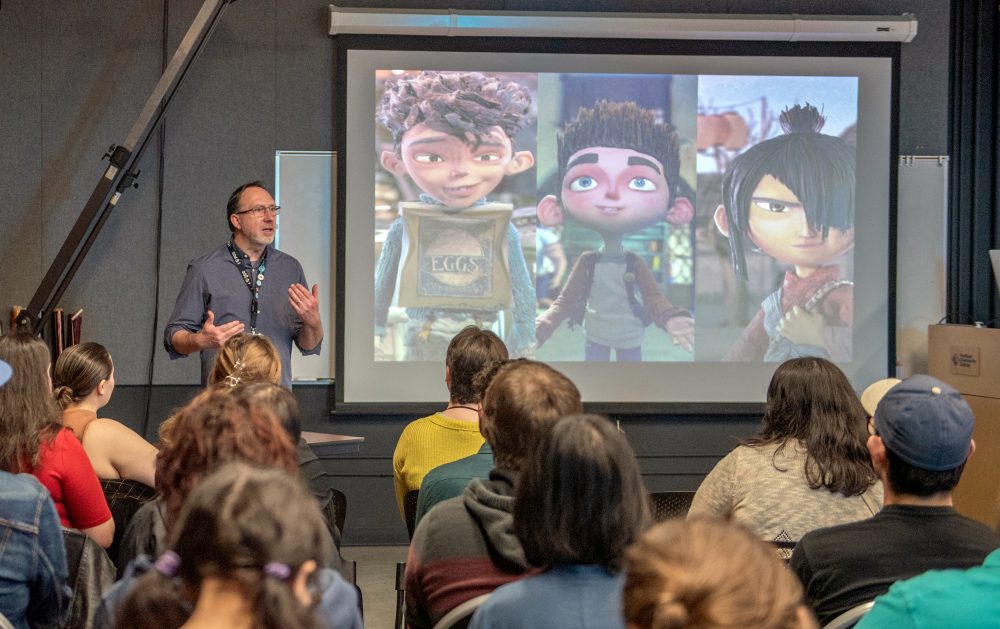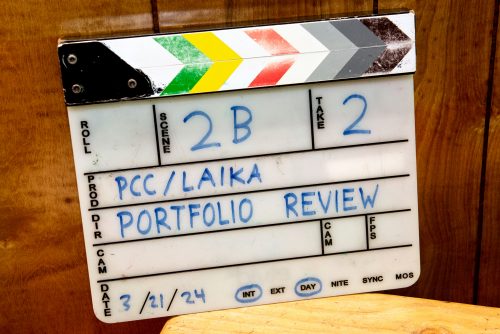This content was published: April 2, 2024. Phone numbers, email addresses, and other information may have changed.
PCC and LAIKA announce landmark partnership to foster diversity in animation
Story by James Hill. Photos by Ric Getter.

“We are so excited to be partnering with LAIKA and its innovative production studio,” said Erik Fauske, PCC multimedia instructor.
Portland Community College has announced a transformative partnership aimed at fostering diversity and inclusivity in the animation industry with LAIKA, the renowned film studio known for its groundbreaking and award-winning animated films “Coraline,” “ParaNorman,” “The Boxtrolls,” “Kubo and the Two Strings” and “Missing Link.” This collaboration reaffirms PCC and LAIKA’s commitment to supporting educational initiatives and promoting equity within the creative arts.
The cornerstone of this partnership is a $60,000 pledge from LAIKA to the PCC Foundation. Over two years, LAIKA will contribute annual gifts of $30,000 to support the newly established LAIKA Scholarship and program funds. This funding aims to create an associate degree in Animation & Motion Graphics, enhancing educational opportunities for aspiring animators in Oregon.
PCC President Dr. Adrien Bennings expressed enthusiasm for the partnership, stating, “This collaboration aligns with PCC’s commitment to providing accessible, culturally responsive education. By working closely with LAIKA, we can ensure that our students receive the training and support they need to succeed in the animation industry.”
This partnership will result in three new “Animation” and “Stop Motion” courses, as well as a proposed Animation & Motion Graphics Program (the degree is not state-approved yet). This would provide students a comprehensive curriculum offering that blends traditional and digital animation techniques. Through co-created studios and industry-standard facilities, students would gain hands-on experience and practical skills under the guidance of experienced professionals.
“LAIKA is honored to partner with PCC,” said LAIKA’s Chief Marketing and Operations Officer David Burke. “As a community of creators, artists, and scientists dedicated to advancing the animation medium, we are delighted to play a part in fostering the skills, aspirations, and talents of PCC’s student body. Our commitment extends to nurturing film narratives that encompass a wide range of experiences and to help grow the next generation of storytellers who will carry our art form forward. We can’t wait to offer mentorship and provide the necessary tools for these artists to thrive and shape the future of animation.”
In addition to financial support, LAIKA will provide valuable insights and feedback to shape the program’s direction and curriculum. Through annual updates and feedback sessions, the studio will play an integral role in guiding students towards industry success. In 2021, LAIKA partnered with Bowie State University to build the first Stop-Motion Animation Studio at a historically Black college/university (HBCU).
The partnership would help tap PCC’s position as a regional hub for digital arts education. The funding by LAIKA will help boost what the college already offers for associate degrees in Multimedia, Multimedia Certificate and Video Production & Emerging Media. The department as a whole offers degrees in Creative Coding & Immersive Technologies, Music & Sonic Arts, and Artificial Intelligence & Cultural Computing. In addition, the college has one of the most diverse student populations with 46% identifying as students of color – and a diverse workforce for the studio to tap into.
Also, the partnership includes a PCC Multimedia student focused internship opportunity and portfolio reviews with LAIKA, supported by the Oregon Film Office.
“We are so excited to be partnering with LAIKA and its innovative production studio,” said Erik Fauske, PCC multimedia instructor. “The scholarship donations and program funds will provide financial support to incoming students and equitable access to cutting edge industry tools. LAIKA’s curriculum feedback, portfolio support and guidance on workflow will impact students to be job ready with relevant skills. At Multimedia, we provide an eclectic array of classes in many areas of production and we are so excited to enhance our animation, visual effects, and motion graphic curriculum.”


